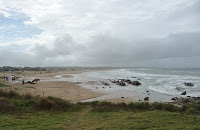
Shoulder-to- shoulder, breast-to-back, the hoards shuffle through the narrow corridors, eyes down to avoid stepping on heels, occasionally  glancing guiltily over each other’s heads at the skilfully carved stone or finely painted maps that decorate the walls of this rigid channel.
glancing guiltily over each other’s heads at the skilfully carved stone or finely painted maps that decorate the walls of this rigid channel.
 glancing guiltily over each other’s heads at the skilfully carved stone or finely painted maps that decorate the walls of this rigid channel.
glancing guiltily over each other’s heads at the skilfully carved stone or finely painted maps that decorate the walls of this rigid channel. Tuned in to the guide’s rapid-fire explanations, they nod automatically – as long as they can hear her on their earbuds, they know she’s within radio range.

In front of priceless Flemish tapestries, monumental figures battling over delicate landscapes; arms raised with iPhones and long-lensed cameras fire flashes that fade the delicate colours.
Logjams gather where families pose for photos with historic  frescoes of famous battles and martyrdoms.
frescoes of famous battles and martyrdoms.
 frescoes of famous battles and martyrdoms.
frescoes of famous battles and martyrdoms. Raphael and Fontana, Bernini and Boromeo fail to register.
The relentless flow pushes past a collection of modern art – ignoring Chagalls and Dalis only steps away – and spills through a small doorway into the celebrated Sistine Chapel.
Straining our necks, we peer upward into the vivid colours and taunt muscles of Michelangelo’s angry old God, jostled by the endless flow of new arrivals, assaulted by uniformed guards shouting for silence.
But this time, the Chapel wins out. Despite the restless carpet of upturned faces, the azule-backed Last Judgement swirls hefty nude figures of saints and sinners around a dynamic Christ, stepping out into the soaring space in Renaissance 3D.
If we stop… and take a deep breath. If we block out the bored children and offensive guards … and focus on the massive, fleshy figures emerging from the deep blue wall, they begin to breath. Silken drapery shifts over flexing muscles, fiery eyes seek you out, outstretched arms twitch as the screams of the damned lift above the forbidden tourist din. Michelangelo, this sculptor turned painter, created life on another plane. His genius lifts us up above the shuffling crowd and waving batons of the guides, and for a moment, the indignity is worthwhile.
-30-
-30-
















































